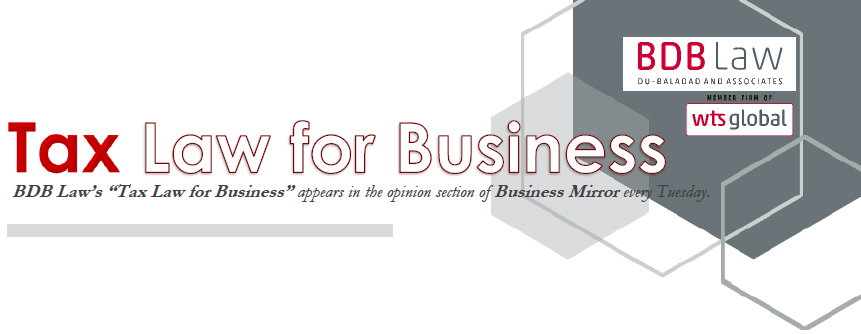Atty. Mabel L. Buted discusses the current withholding tax system and the challenges taxpayers face under the system.

Struggles under the Withholding Tax System
By: Atty. Mabel L. Buted
"With the present practices, however, taxpayers are struggling to have their excess taxes paid recovered in the form of refund. The Bureau seldom acts on refund claims and even if acted upon, disallowances cannot be avoided. That’s the reason why a number of refund claims are elevated to the Courts. If the BIR ever acts upon a claim, this will undergo the audit process. In undertaking such audit, some documents are requested which are not presently warranted – like proof of remittance of withholding tax and the alphalist of income payors – and unless these documents are provided, the claim is denied."
The withholding tax system of collecting taxes by the Bureau of Internal Revenue (Bureau) has been in place for a long time. Under the said system, the taxes due from the income earners are collected in advance at source – from the payors of the income who are constituted as the withholding tax agents. The withholding tax agents withhold at special rates and remit the taxes withheld to the government on a monthly basis or as often as required by the applicable rules. Except for the final withholding taxes, the taxes withheld shall be credited against the taxes due on the related income at the end of a quarter or year when the income earner is required to file his tax returns.
While the system reduces the collection efforts of the government, the current withholding tax rules present some struggles on the recipients of income.
 The first one relates to the claiming of tax credit. The present rules allow the income earners to claim the tax withheld as tax credit so long as there is proof that the tax was withheld by presenting the withholding tax certificate or BIR Form No. 2307 provided by the payor. The payor provides the said certificate when it withholds the tax – that is, when an expense or asset is accrued or recorded, or when the same is paid, whichever comes first. So, here is a situation where the tax withheld may already be utilized as tax credit even if the corresponding income has not been earned. And the current rules allow this. However, during tax investigations, the examiners would usually treat the income payment upon which the tax was withheld as already earned and assess the corresponding income tax due. The taxpayer is then faced with the dilemma of claiming the tax credit but with the possible risk of paying additional tax on the income allegedly already earned.
The first one relates to the claiming of tax credit. The present rules allow the income earners to claim the tax withheld as tax credit so long as there is proof that the tax was withheld by presenting the withholding tax certificate or BIR Form No. 2307 provided by the payor. The payor provides the said certificate when it withholds the tax – that is, when an expense or asset is accrued or recorded, or when the same is paid, whichever comes first. So, here is a situation where the tax withheld may already be utilized as tax credit even if the corresponding income has not been earned. And the current rules allow this. However, during tax investigations, the examiners would usually treat the income payment upon which the tax was withheld as already earned and assess the corresponding income tax due. The taxpayer is then faced with the dilemma of claiming the tax credit but with the possible risk of paying additional tax on the income allegedly already earned.
Another problem relates to the excess taxes withheld. Under the current rules, almost all types of income are subject to withholding taxes, and the bases are the gross amounts. Because of these factors, plus that fact that the withholding tax rates are high, oftentimes, the taxes collected and withheld on income are more than the final income tax due at year-end, resulting in excess tax credits. And the only available remedies to utilize or recover these excess taxes are – to carry over or to claim for a refund or tax credit certificate. Notwithstanding that these have already been paid in advance, the Bureau would, during tax audits, not consider these as tax credits against the resulting deficiency taxes due unless tax credit certificates are presented.
Taxpayers would normally opt for the carry-over, with the hope that they can use the excess amount as payment of the income taxes in the succeeding periods. This is so because refund process involves difficult and tedious task.
With the present practices, however, taxpayers are struggling to have their excess taxes paid recovered in the form of refund. The Bureau seldom acts on refund claims and even if acted upon, disallowances cannot be avoided. That’s the reason why a number of refund claims are elevated to the Courts. If the BIR ever acts upon a claim, this will undergo the audit process. In undertaking such audit, some documents are requested which are not presently warranted – like proof of remittance of withholding tax and the alphalist of income payors – and unless these documents are provided, the claim is denied.
Further, based on a recent pronouncement by the Court (G.R. Nos. 242647 & 243814, March 15, 2022), in the refund of excess withholding taxes, the taxpayer needs to prove not only the taxes withheld in the current period, but also the prior year’s excess tax credits. If the prior year’s excess tax credits are applied against the income tax due for the period of claim, these prior year’s excess tax credits must be supported as well with withholding tax certificates. Otherwise, the income tax due will be paid by the creditable taxes withheld for the current period, thus reducing or eliminating the refundable amount.
The withholding tax system is just a method in the collection of taxes. Even in this system, taxpayers should be paying only the taxes that are properly due from them. So, rules and processes should not be difficult for the recovery of unused advance tax payments.
The author is a junior partner of Du-Baladad and Associates Law Offices (BDB Law), a member-firm of WTS Global.
The article is for general information only and is not intended, nor should be construed as a substitute for tax, legal or financial advice on any specific matter. Applicability of this article to any actual or particular tax or legal issue should be supported therefore by a professional study or advice. If you have any comments or questions concerning the article, you may e-mail the author at This email address is being protected from spambots. You need JavaScript enabled to view it. or call 8403-2001 local 160.



